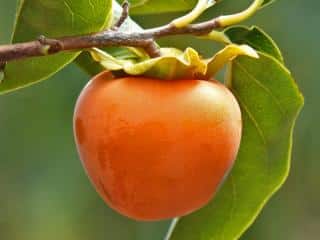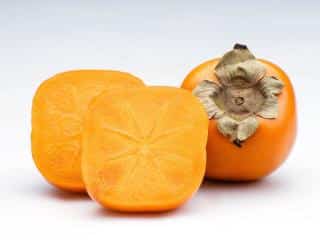

Though its botanical name is “Diospyros kaki“, you might mistaken it for a tomato. Smooth skin, color varying from orange to red based on variety and ripeness level: say hello to this tomato look-alike.It’s part of the Ebenaceae family and is native to China. We often know kaki as the fruit of the persimmon tree. The fruit shares its name and goes by either “kaki” or “persimmon“.
When unripe and still green, it’s acrid, astringent, and not edible. When ripe, its flesh becomes tender, sweet and juicy. That’s when kaki truly delights our palates with its sweet and mild flavor. It’s chock-full of vitamins, minerals, and antioxidants, truly a nutritional powerhouse.
In therapy, it’s a great source of fiber to aid your gut and bolster body’s defenses. Plus, it packs a punch with its energizing and invigorating properties. Easy to store, kaki lets you dabble into diverse culinary explorations:
 Also called “persimmon apple“, “persimmon“, or “date-plum“, depending on the species and variety, persimmon made its appearance in the West in 19th century. Its first trees found roots in Toulon, France in 1870. A newfound exotic fruit, persimmon cultivation expanded progressively to Mediterranean areas, and even regions where temperatures plunge to 5°F (-15°C).
Also called “persimmon apple“, “persimmon“, or “date-plum“, depending on the species and variety, persimmon made its appearance in the West in 19th century. Its first trees found roots in Toulon, France in 1870. A newfound exotic fruit, persimmon cultivation expanded progressively to Mediterranean areas, and even regions where temperatures plunge to 5°F (-15°C).
Enjoyable all year round (especially in fall), this fruit full of exceptional flavors and packed with vitamins comes highly recommended, especially during the winter season.
There are two known species: American persimmon and Asian persimmon.
 Rich in vitamins (A, B and C), minerals (potassium, phosphorus, calcium, magnesium, sodium), and even manganese and selenium, persimmon is astringent, diuretic, and detoxifying. Also an energizing and tonic fruit, it fights harmful bacteria with its high vitamin C content. Its antioxidant properties, thanks to carotenoids, tannins, flavonoids (gallic acid, catechins, proanthocyanidins…), contribute to coronary disease treatments. It’s essential for children’s growth, stimulating immune system and improving vision.
Rich in vitamins (A, B and C), minerals (potassium, phosphorus, calcium, magnesium, sodium), and even manganese and selenium, persimmon is astringent, diuretic, and detoxifying. Also an energizing and tonic fruit, it fights harmful bacteria with its high vitamin C content. Its antioxidant properties, thanks to carotenoids, tannins, flavonoids (gallic acid, catechins, proanthocyanidins…), contribute to coronary disease treatments. It’s essential for children’s growth, stimulating immune system and improving vision.
Its role as a protector of stomach and cleaner of intestines gives it digestive virtues: its fibers promote lipid metabolism. A true soothing fruit, “persimmon” also helps with sluggish digestion (constipation). It is also known for its properties that boost immune defenses, and fight colds and flu. In treatment and prevention of diabetes, persimmon leaves inhibit alpha-amylase and increase insulin sensitivity. To get smooth, beautiful skin, consuming “date-plum” is often recommended.
Ripe persimmon is delicious as a dessert or mid-morning snack: it’s best to consume it mainly in winter to maintain vigor, without overdoing it because persimmon, after all, is a potent laxative.
Good to know: Consuming persimmon is not advised for those dealing with digestive issues, diabetics, and overweight individuals. In case of doubt, never hesitate to seek your doctor’s opinion.